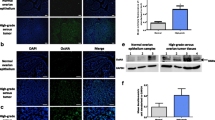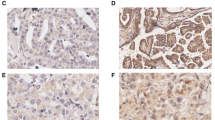Abstract
Purpose
To investigate the role of integrin β3 in invasive features of ovarian cancer SKOV3 cells, by comparing different metastatic subclones.
Methods
In the present study, two cell subclones, termed as S1 and S21, which possessed high and low metastatic potential, respectively, were isolated and established from human ovarian cancer parental cell line SKOV3 by the limited dilution method. The expressions of integrin αv, integrin αvβ3, integrin β3, E-cadherin, FAK and ILK in the two cell subclones were compared by means of real-time RT-PCR or flow cytometry. Subsequently, S21 was transfected with siRNA for integrin β3 and the effects of transfection were examined by methyl thiazolyl tetrazolium (MTT) assay, colony formation assay, Matrigel invasion assay and cell migration assay.
Results
The expressions of integrin αvβ3, integrin β3 and E-cadherin were markedly down-regulated in S1; however, there were no significant differences in the expressions of integrin αv, FAK and ILK β. Of note, more than 70% knockdown of integrin β3 expression was obtained by siRNA technique. The integrin β3-siRNA-transfected cells showed significant increases in cell proliferation, cell migration and invasive activity in contrast with the mock-transfected cells. The expressions of integrin αvβ3 and E-cadherin were lower in the integrin β3-siRNA-transfected cells compared to the mock control.
Conclusion
Integrin β3, like E-cadherin, may be also a suppressor gene down-regulating invasive features of ovarian cancer cells in SKOV3 cell subclones.








Similar content being viewed by others
References
Albini A, Iwamoto Y, Kleinman HK et al (1987) Arapid in vitro assay for quantitating the invasive potential of tumor cells. Cancer Res 47:3239–3245
Arnaout MA (2002) Integrin structure: new twists and turns in dynamic cell adhesion. Immunol Rev 186:125–140. doi:10.1034/j.1600-065X.2002.18612.x
Bauer K, Mierke C, Behrens J (2007) Expression profiling reveals genes associated with transendothelial migration of tumor cells: a functional role for alphavbeta3 integrin. Int J Cancer 121:1910–1918. doi:10.1002/ijc.22879
Baum O, Hlushchuk R, Forster A, Greiner R, CléZardin P, Zhao Y et al (2007) Increased invasive potential and up-regulation of MMP-2 in MDA-MB-231 breast cancer cells expressing the beta3 integrin subunit. Int J Oncol 30:325–332
Bian B, Ma C, You J, Ning J, Fang W, Zheng J (2003) The effects of TMSG-1 gene transfection on metastatic phenotype of pg cancer cells. Beijing Da Xue Xue Bao 35:18–22
Bojesen SE, Kjaer SK, Høgdall EV et al (2005) Increased risk of ovarian cancer in integrin beta3 Leu33Pro homozygotes. Endocr Relat Cancer 12(4):945–952. doi:10.1677/erc.1.01083
Brun JL, Feyler A, Chêne G, Saurel J, Brun G, Hocké C (2000) Long-term results and prognostic factors in patients with epithelial ovarian cancer. Gynecol Oncol 78:21–27. doi:10.1006/gyno.2000.5805
Brüning A, Köhler T, Quist S, Wang-Gohrke S, Moebus VJ, Kreienberg R et al (2001) Adenoviral transduction efficiency of ovarian cancer cells can be limited by loss of integrin beta3 subunit expression and increased by reconstitution of integrin alphavbeta3. Hum Gene Ther 12:391–399. doi:10.1089/10430340150504019
Carreiras F, Rigot Y, Cruet S et al (1999) Migration properties of the human ovarian adenocarcinoma cell line IGROV1: importance of alpha (v) beta3 integrins and vitronectin. Int J Cancer 80:285–294. doi :10.1002/(SICI)1097-0215(19990118)80:2<285::AID-IJC19>3.0.CO;2-L
Cruet-Hennequart S, Maubant S, Luis J, Gauduchon P, Staedel C, Dedhar S (2003) Alpha(v) integrins regulate cell proliferation through integrin-linked kinase (ILK) in ovarian cancer cells. Oncogene 22:1688–1702. doi:10.1038/sj.onc.1206347
D’Abaco GM, Kaye AH (2007) Integrins: molecular determinants of glioma invasion. J Clin Neurosci 14:1041–1048. doi:10.1016/j.jocn.2007.06.019
Fidler IJ, Kripke ML (1977) Metastasis results from preexisting variant cells within a malignant tumor. Science 197:893–895. doi:10.1126/science.887927
Fidler IJ (1990) Critical factors in the biology of human cancer metastasis: twenty-eighth G H. A. Clowes Memorial Award Lecture. Cancer Res 50:6130–6138
Geiger B, Bershadsky A, Pankov R, Yamada KM (2001) Transmembrane crosstalk between the extracellular matrix–cytoskeleton crosstalk. Nat Rev Mol Cell Biol 2:793–805. doi:10.1038/35099066
Grzesiak JJ, Ho JC, Ar Moossa, Bouvet M (2007) The integrin–extracellular matrix axis in pancreatic cancer. Pancreas 35:293–301
Hapke S, Kessler H, Luber B et al (2003) Ovarian cancer cell proliferation and motility is induced by engagement of integrin alpha(v)beta3/Vitronectin interaction. Biol Chem 384:1073–1083. doi:10.1515/BC.2003.120
Horiuchi A, Konishi I (2004) Mechanism of ovarian cancer metastasis: changes in E-cadherin expression. Nippon Rinsho 62:463–466
Hata F, Nishimori H, Yasoshima T, Tanaka H, Ohno K, Yanai Y et al (2004) Profiling analysis of differential gene expression between hematogenous and peritoneal metastatic sublines of human pancreatic cancer using a DNA chip. J Exp Clin Cancer Res 23:513–520
Jakubowska A, Gronwald J, Menkiszak J et al (2007) Integrin beta3 Leu33Pro polymorphism increases BRCA1-associated ovarian cancer risk. J Med Genet 44:408–411. doi:10.1136/jmg.2006.047498
Jemal A, Siegel R, Ward E, Murray T, Xu J, Thun MJ (2007) Cancer statistics, 2007. CA Cancer J Clin 57:43–66
Kallio JP, Mikkelsson J, Tammela TL, Karhunen PJ, Kellokumpu-Lehtinen P (2006) Genetic variation in platelet integrin alphabeta (GPIIb/IIIa) and the metastatic potential of renal cell carcinoma. BJU Int 98:201–204. doi:10.1111/j.1464-410X.2006.06196.x
Kanamori M, Vanden Berg SR, Bergers G, Berger MS, Pieper RO (2004) Integrin beta3 overexpression suppresses tumor growth in a human model of gliomagenesis: implications for the role of beta3 overexpression in glioblastoma multiforme. Cancer Res 64:2751–2758. doi:10.1158/0008-5472.CAN-03-3354
Kasirer-Friede A, Kahn ML, Shattil SJ (2007) Platelet integrins and immunoreceptors. Immunol Rev 218:247–264. doi:10.1111/j.1600-065X.2007.00532.x
Kee SH, Steinert PM (2001) Microtubule disruption in keratinocytes induces cell–cell adhesion through activation of endogenous E-cadherin. Mol Biol Cell 12:1983–1993
Knudsen KA, Soler AP, Johnson KR, Wheelock MJ (1995) Interaction of alpha-actinin with the cadherin/catenin cell–cell adhesion complex via alpha-catenin. J Cell Biol 130:67–77. doi:10.1083/jcb.130.1.67
Le Tourneau C, Faivre S, Raymond E (2007) The role of integrins in colorectal cancer. Oncology 21:21–24 Williston Park
Legate KR, Montañez E, Kudlacek O, Fässler R (2006) ILK, PINCH and parvin: the tIPP of integrin signalling. Nat Rev Mol Cell Biol 7:20–31. doi:10.1038/nrm1789
Lewis JE, Jensen PJ, Johnson KR, Wheelock MJ (1994) E-cadherin mediates adherens junction organization through protein kinase C. J Cell Sci 107:3615–3621
Li Y, Tang Y, Ye L, Liu B, Liu K, Chen J et al (2003) Establishment of a hepatocellular carcinoma cell line with unique metastatic characteristics through in vivo selection and screening for metastasis-related genes through cDNA microarray. J Cancer Res Clin Oncol 129:43–51. doi:10.1007/s00432-003-0493-z
Li SG, Ye ZY, Zhao ZS, Tao HQ, Wang YY, Niu CY (2008) Correlation of integrin beta3 mRNA and vascular endothelial growth factor protein expression profiles with the clinicopathological features and prognosis of gastric carcinoma. World J Gastroenterol 14:421–427. doi:10.3748/wjg.14.421
Liapis H, Adler LM, Wick MR, Rader JS (1997) Expression of alpha(v)beta3 integrin is less frequent in ovarian epithelial tumors of low malignant potential in contrast to ovarian carcinomas. Hum Pathol 28:443–449. doi:10.1016/S0046-8177(97)90033-2
Liu Y, Zheng J, Fang W, You J, Wang J, Cui X et al (2001) Identification of metastasis-associated gene G3BP by differential display in human cancer cell sublines with different metastatic potentials G3BP as highly expressed in non-metastatic. Chin Med J 114:35–38
Mitra SK, Schlaepfer DD (2006) Integrin-regulated FAK-Src signaling in normal and cancer cells. Curr Opin Cell Biol 18:516–523. doi:10.1016/j.ceb.2006.08.011
Nakano T, Tani M, Ishibashi Y, Kimura K, Park YB et al (2003) Biological properties and gene expression associated with metastatic potential of human osteosarcoma. Clin Exp Metastasis 20:665–674. doi:10.1023/A:1027355610603
Neto DS, Pantaleão L, de Sá BC, Landmam G (2007) Alpha-v-beta3 integrin expression in melanocytic nevi and cutaneous melanoma. J Cutan Pathol 34:851–856. doi:10.1111/j.1600-0560.2007.00730.x
Parise LV, Lee J, Juliano RL (2000) New aspects of integrin signaling in cancer. Semin Cancer Biol 10:407–414. doi:10.1006/scbi.2000.0337
Parkin DM, Bray F, Ferlay J, Pisani P (2005) Global cancer statistics, 2002. CA Cancer J Clin 55:74–108
Radinsky R, Weisberg HZ, Staroselsky AN, Fidler IJ (1992) Expression level of the nm23 gene in clonal populations of metastatic murine and human neoplasms. Cancer Res 52:5808–5814
Robertson JH, Am Iga, Sales KM, Winslet MC, Seifalian AM (2008) Integrins: a method of early intervention in the treatment of colorectal liver metastases. Curr Pharm Des 14:296–305. doi:10.2174/138161208783413284
Sato T, Miwa A (2002) Ets-1 and integrin beta3 for lung metastasis from colorectal cancer. APMIS 110:347–353. doi:10.1034/j.1600-0463.2002.100410.x
Sood AK, Coffin JE, Schneider GB, Fletcher MS, DeYoung BR et al (2004) Biological significance of focal adhesion kinase in ovarian cancer: role in migration and invasion. Am J Pathol 165:1087–1095
Switala-Jelen K, Dabrowska K, Opolski A, Lipinska L, Nowaczyk M, Gorski A (2004) The biological functions of beta3 integrins. Folia Biol (Praha) 50:143–152
Tanaka H, Hata F, Nishimori H, Honmou O, Yasoshima T, Nomura H et al (2003) Differential gene expression screening between parental and highly metastatic pancreatic cancer variants using a DNA microarray. J Exp Clin Cancer Res 22:307–313
Tucker GC (2002) Inhibitors of integrins. Curr Opin Pharmacol 2:394–402. doi:10.1016/S1471-4892(02)00175-3
Voutilainen KA, Anttila MA, Sillanpää SM, Ropponen KM, Saarikoski SV, Juhola MT et al (2006) Prognostic significance of E-cadherin-catenin complex in epithelial ovarian cancer. J Clin Pathol 59:460–467. doi:10.1136/jcp.2005.029876
Watson-Hurst K, Becker D (2006) The role of N-cadherin, MCAM and beta3 integrin in melanoma progression, proliferation, migration and invasion. Cancer Biol Ther 5:1375–1382
Wu C, Cipollone J, Maines-Bandiera S, Tan C, Karsan A, Auersperg N et al (2008) The morphogenic function of E-cadherin-mediated adherens junctions in epithelial ovarian carcinoma formation and progression. Differentiation 76:193–205. doi:10.1111/j.1432-0436.2007.00193.x
Zhang Q, Furukawa K, Chen HH, Fujinawa R, Kozutsumi Y et al (2006) Down-regulation of caveolin-1 in mouse Lewis lung cancer P29 is a causal factor for the malignant properties in a high-metastatic subline. Oncol Rep 16:289–294
Acknowledgments
This study was supported by a grant-in-aid for scientific research (2007BS03025, Funds for Doctors) from the Department of Science and Technology of Shandong Province.
Author information
Authors and Affiliations
Corresponding author
Rights and permissions
About this article
Cite this article
Chen, J., Zhang, J., Zhao, Y. et al. Integrin β3 down-regulates invasive features of ovarian cancer cells in SKOV3 cell subclones. J Cancer Res Clin Oncol 135, 909–917 (2009). https://doi.org/10.1007/s00432-008-0526-8
Received:
Accepted:
Published:
Issue Date:
DOI: https://doi.org/10.1007/s00432-008-0526-8




